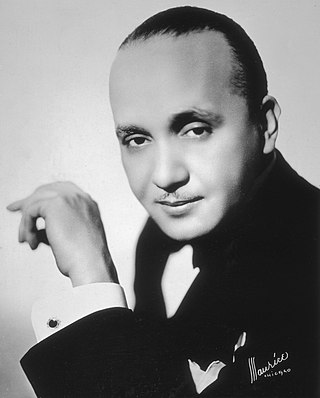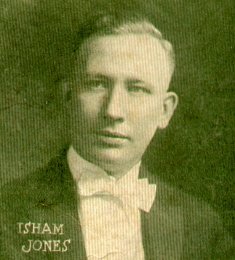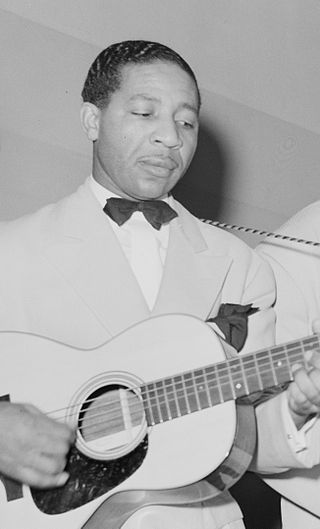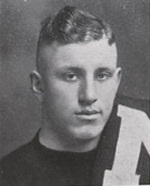Related Research Articles

George Gershwin was an American composer and pianist whose compositions spanned popular, jazz and classical genres. Among his best-known works are the orchestral compositions Rhapsody in Blue (1924) and An American in Paris (1928), the songs "Swanee" (1919) and "Fascinating Rhythm" (1924), the jazz standards "Embraceable You" (1928) and "I Got Rhythm" (1930), and the opera Porgy and Bess (1935), which included the hit "Summertime".

James Fletcher Hamilton Henderson was an American pianist, bandleader, arranger and composer, important in the development of big band jazz and swing music. He was one of the most prolific black musical arrangers and, along with Duke Ellington, is considered one of the most influential arrangers and bandleaders in jazz history. Henderson's influence was vast. He helped bridge the gap between the Dixieland and the swing eras. He was often known as "Smack" Henderson.

George Clarence Brunies, a.k.a.Georg Brunis, was an American jazz trombonist, who was part of the dixieland revival. He was known as "The King of the Tailgate Trombone".

Isham Edgar Jones was an American bandleader, saxophonist, bassist and songwriter.

Albert Edwin Condon was an American jazz banjoist, guitarist, and bandleader. A leading figure in Chicago jazz, he also played piano and sang. He also owned a self-named night club in New York City.

Ben Pollack was an American drummer and bandleader from the mid-1920s through the swing era. His eye for talent led him to employ musicians such as Benny Goodman, Jack Teagarden, Glenn Miller, Jimmy McPartland, and Harry James. This ability earned him the nickname the "Father of Swing".

Alonzo "Lonnie" Johnson was an American blues and jazz singer, guitarist, violinist and songwriter. He was a pioneer of jazz guitar and jazz violin and is recognized as the first to play an electrically amplified violin.

Richard Davis was an American jazz bassist. Among his best-known contributions to the albums of others are Eric Dolphy's Out to Lunch!, Andrew Hill's Point of Departure, and Van Morrison's Astral Weeks, of which critic Greil Marcus wrote, "Richard Davis provided the greatest bass ever heard on a rock album."

William Roy "Link" Lyman, also sometimes known as Roy Lyman, was an American professional football player.

James Dugald "Jimmy" McPartland was an American cornetist. He worked with Eddie Condon, Art Hodes, Gene Krupa, Benny Goodman, Jack Teagarden, and Tommy Dorsey, often leading his own bands. He was married to pianist Marian McPartland.

Hal Mohr, A.S.C. was a famed movie cinematographer who won an Oscar for his work on the 1935 film A Midsummer Night's Dream. He was awarded another Oscar for The Phantom of the Opera in 1943 and received a nomination for The Four Poster in 1952.

George Farley "Boots" Grantham was an American Major League Baseball second baseman who played for the Chicago Cubs, Pittsburgh Pirates, Cincinnati Reds, and New York Giants between 1922 and 1934.

George Henry Irving was an American film actor and director.
Elmer Schoebel was an American jazz pianist, composer, and arranger.
Timeless Records is a jazz record label based in the Netherlands.
James Palao was an American jazz musician.

Alfred Orendorff was an Illinois lawyer and politician.

The period from the end of the First World War until the start of the Depression in 1929 is known as the "Jazz Age". Jazz had become popular music in America, although older generations considered the music immoral and threatening to cultural values. Dances such as the Charleston and the Black Bottom were very popular during the period, and jazz bands typically consisted of seven to twelve musicians. Important orchestras in New York were led by Fletcher Henderson, Paul Whiteman and Duke Ellington. Many New Orleans jazzmen had moved to Chicago during the late 1910s in search of employment; among others, the New Orleans Rhythm Kings, King Oliver's Creole Jazz Band and Jelly Roll Morton recorded in the city. However, Chicago's importance as a center of jazz music started to diminish toward the end of the 1920s in favor of New York.
The Jazz Singer is a play written by Samson Raphaelson, based on his short story "The Day of Atonement". Producers Albert Lewis and Max Gordon staged it on Broadway, where it debuted at the Fulton Theatre in 1925. A highly influential movie adaptation was released in 1927.
References
- ↑ "George Orendorff". The New Grove Dictionary of Jazz . 2nd edition, 2004.